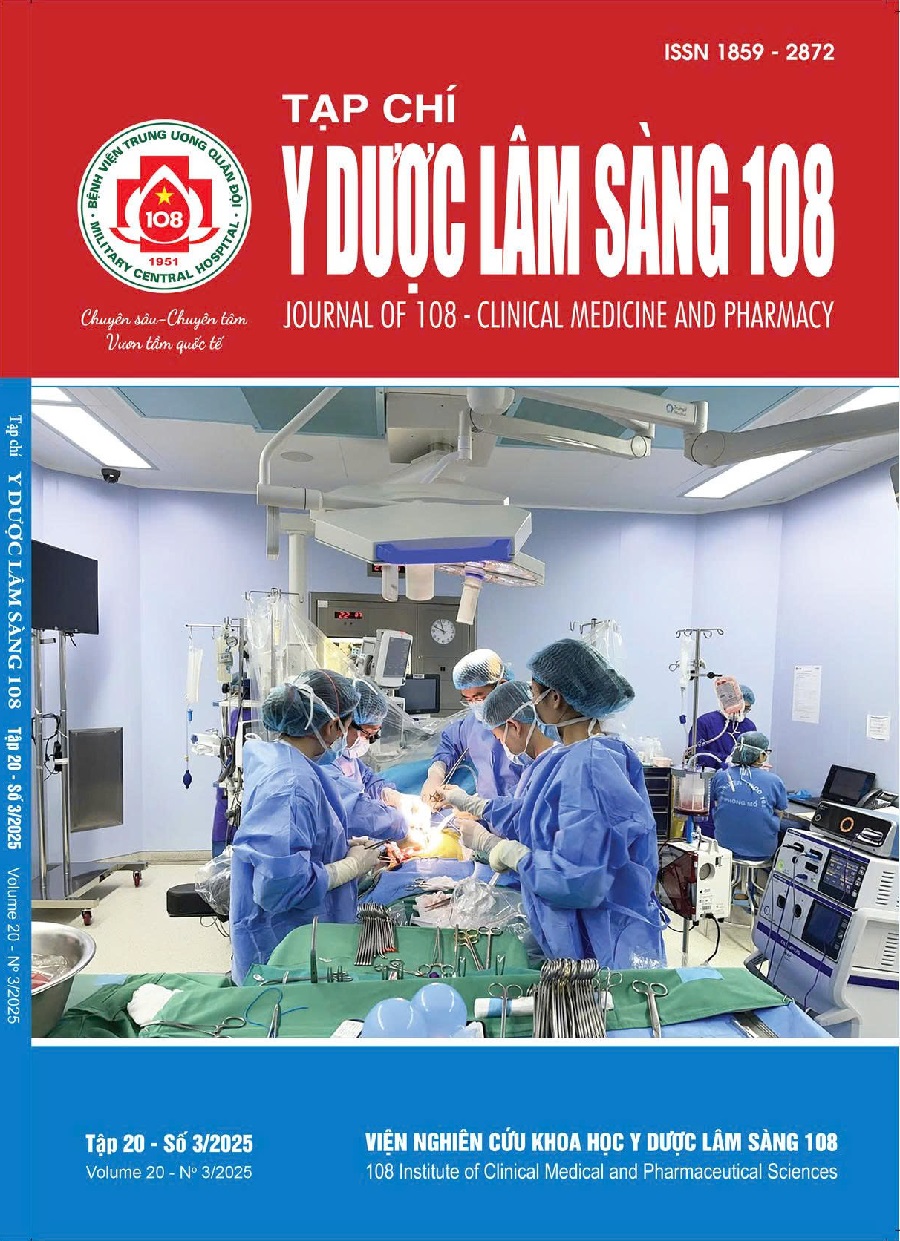Building a predictive model for continuous renal replacement therapy in patients with sepsis
Main Article Content
Keywords
Abstract
Objective: The study aimed to develop a machine learning model using the XGBoost algorithm to predict continuous renal replacement therapy (CRRT) in patients with sepsis. Subject and method: This was a cross-sectional study involving 530 patients diagnosed with sepsis. Clinical and paraclinical parameters were collected at the time of diagnosis. Patients were then followed longitudinally to identify those who required CRRT. The sample size was divided into two groups in an 80:20 ratio. 80% of the sample was used to train the XGBoost model based on clinical and paraclinical parameters, while 20% was used to evaluate the model’s performance. Result: The model included 8 parameters: age, gender, portal entry of infection, serum urea concentration, serum creatinine concentration, blood lactate, and arterial pH. It achieved optimal performance with a sensitivity of 92.3%, specificity of 92.4%, accuracy of 91%, precision of 85.7%, and a very good AUC (0.95). Conclusion: The model based on the XGBoost algorithm had significant value in predicting CRRT in patients with sepsis.
Article Details
References
2. STARRT-AKI Investigators; Canadian Critical Care Trials Group; Australian and New Zealand Intensive Care Society Clinical Trials Group; United Kingdom Critical Care Research Group; Canadian Nephrology Trials Network; Irish Critical Care Trials Group; Bagshaw SM, Wald R, Adhikari NKJ et al (2020) Timing of Initiation of Renal-Replacement Therapy in Acute Kidney Injury. New England Journal of Medicine. 2020; 383(3): 240-251. doi:10.1056/NEJMoa2000741.
3. Uhel F, Peters-Sengers H, van der Poll T (2018) Initiation of renal replacement therapy in patients with sepsis: more to it than meets the eye. Ann Transl Med 6(2):S130. doi:10.21037/atm.2018.12.36.
4. Klein SJ, Brandtner AK, Lehner GF et al (2018) Biomarkers for prediction of renal replacement therapy in acute kidney injury: A systematic review and meta-analysis. Intensive Care Med 44(3): 323-336. doi:10.1007/s00134-018-5126-8.
5. Chen T, Guestrin C (2016) XGBoost: A Scalable Tree Boosting System. 6: 785-794.
6. Singer M, Deutschman CS, Seymour CW et al (2016) The third international consensus definitions for sepsis and septic shock (Sepsis-3). JAMA 315(8):801-810. doi:10.1001/jama.2016.0287.
7. Khwaja A (2012) KDIGO clinical practice guidelines for acute kidney injury. Nephron Clin Pract. 120(4): 179-184. doi:10.1159/000339789.
8. An JN, Kim SG, Song YR (2021) When and why to start continuous renal replacement therapy in critically ill patients with acute kidney injury. Kidney Res Clin Pract 40(4): 566-577. doi:10.23876/j.krcp.21.043.
9. Lameire N, Vanmassenhove J (2018) Timing of dialysis in sepsis and acute respiratory distress syndrome. Am J Respir Crit Care Med 198(1):4-5. doi:10.1164/rccm.201801-0129ED.
10. Ostermann M, Legrand M, Meersch M, Srisawat N, Zarbock A, Kellum JA (2024) Biomarkers in acute kidney injury. Annals of Intensive Care 14(1):145. doi: 10.1186/s13613-024-01360-9.
11. De Vlieger G, Koyner JL, Ostermann M (2025) Can we use artificial intelligence to better treat acute kidney injury? Intensive Care Med 51(1): 160-162. doi:10.1007/s00134-024-07743-7.
12. Meersch M, Weiss R, Gerss J et al (2023) Predicting the Development of Renal Replacement Therapy Indications by Combining the Furosemide Stress Test and Chemokine (C-C Motif) Ligand 14 in a Cohort of Postsurgical Patients. Crit Care Med 51(8): 1033-1042. doi:10.1097/ccm.0000000000005849.
13. Vanmassenhove J, Kielstein J, Jörres A, Biesen WV (2017) Management of patients at risk of acute kidney injury. Lancet 389(10084): 2139-2151. doi:10.1016/s0140-6736(17)31329-6.
14. Kellen M, Aronson S, Roizen MF, Barnard J, Thisted RA (1994) Predictive and diagnostic tests of renal failure: A review. Anesthesia & Analgesia 78(1):134-142.
15. Motzkus CA, Luckmann R (2017) Does infection site matter? A systematic review of infection site mortality in sepsis. Journal of intensive care medicine 32(8): 473-479.
16. Soni J, Sinha S, Pandey R (2024) Understanding bacterial pathogenicity: A closer look at the journey of harmful microbes. Frontiers in Microbiology 15:1370818.
17. Caraballo C, Jaimes F (2019) Organ dysfunction in sepsis: An ominous trajectory from infection to death. The Yale journal of biology and medicine 92(4): 629.
18. De Waele J, Lipman J, Sakr Y et al (2014) Abdominal infections in the intensive care unit: characteristics, treatment and determinants of outcome. BMC infectious diseases 14: 1-17.
19. Abe T, Tokuda Y, Shiraishi A et al (2019) In-hospital mortality associated with the misdiagnosis or unidentified site of infection at admission. Critical Care 23: 1-9.
20. Yue S, Li S, Huang X et al (2022) Machine learning for the prediction of acute kidney injury in patients with sepsis. Journal of Translational Medicine 20(1): 215. doi:10.1186/s12967-022-03364-0.
 ISSN: 1859 - 2872
ISSN: 1859 - 2872
